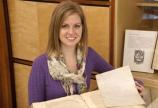Grad student discovers pages from an 1856 BC marriage register
- Erin Fairweather

This past March, I made a little discovery while doing primary source research for a detailed bibliography and history of the book graduate course Old Books in New Libraries. Offered by the French department and taught by Dr H&e#180;lène Cazes, this class met in UVic Special Collections. We explored the history and mechanics of book printing, as well as how to write bibliographical notices. We got to spend our time digging through treasures from the library vault, with ancient and unique books brought up by the cartload for us to examine.
The project that I was working on involved 18th-century dictionaries from the Seghers Collection. This collection has been on permanent loan to the library from the Catholic Diocese of Victoria since 1976, and consists of about 4,000 volumes. I was looking at what made the copies of dictionaries, encyclopedia volumes and lexicons within this collection unique…. i.e. mistakes in collation, pagination, as well as annotations and marks of readership or ownership.
After going through several volumes of different dictionaries, I came across Le Dictionnaire de cas de conscience… by Jean Pontas (1638-1728). This book is printed in folio, consists of three volumes, and measures 40 cm in height.
As I flipped through the pages one by one, hoping to find some clever annotations, I uncovered, slipped between the pages, an old document that sparked my interest, and the history of this book began to take a different shape.
Someone had left a lined, legal-sized folio, most likely from a notebook. Looking closer, I discovered that this document contained ï¬ve marriage registrations, dated from July 21, 1856, at Fort Langley. I felt a twinge of realization and excitement; I am myself from Langley! I noted that this manuscript was written in ink, and that the signatures were authentic (this includes the shaky "x"s marked by those who did not know how to write). In fact, I recognized some of the names of the signed witnesses, in particular, James Murray Yale, chief trader and officer in charge of Fort Langley at that time.
I snapped some photos, transcribed the text by hand, and ran back to my office to do a little research on the characters involved in these marriages.
After spending weeks going between the library and BC Archives, I can say that this is an original record of intermarriage between men of the Hudson's Bay Company and Coast Salish women. These are pages from Rev. Lootens' notebook, carried with him on his visit to Fort Langley where he performed and recorded baptisms and marriages. After he brought them back to his diocese in Victoria, someone copied the content into the main register. Somehow this artifact was then slipped into a dictionary at St. Andrew's, where it was forgotten or lost until its rediscovery in March.
I believe that this document's journey and subsequent discovery acts as evidence of the benefits that come from doing primary-source research. Actually examining a main source first-hand brings discovery; you are more open-minded to new findings, and a certain connection is created between yourself and the object, the text you are studying. I have since been in contact with descendents in Fort Langley of the married couples as well as sharing my discovery at the People of the River Conference hosted by the St&o#180;:lÅ Nation.
Erin Fairweather is a master's student in te Department of French

